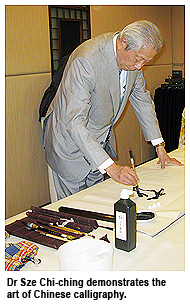Salon promotes Chinese calligraphy and painting
Mirror Fung
The prominent business leader Dr Sze Chi-ching shared his thoughts on the art of Chinese calligraphy at a City Cultural Salon held by the Cultural and Sports Committee of City University of Hong Kong (CityU) on 26 September.
Dr Sze, President of the Calligraphy and Painting Study Association of Hong Kong Fukienese, has been passionate about Chinese calligraphy since childhood.
In his opinion, people can start to learn Chinese calligraphy by copying examples, but eventually the calligraphy will reflect the character and spiritual outlook of the writer.
To advance one’s skill, the learner needs to practice diligently and nurture a stronger sense of cultural values. “Chinese characters combine sound, form and meaning to express the artist’s spirit and emotions,” he said.
Dr Sze said he was only a calligraphy lover, but not a professional calligrapher, though he has acquired a great deal of insight over the years.
“There have been many master calligraphers through the ages, with Wang Xizhi, Yan Zhengqing, and Su Shi the most well-known. To me, the most influential calligrapher, though, is not Wang Xizhi but Yan Zhengqing,” Dr Sze said.
“Before Yan Zhengqing, most calligraphers followed the style of the two Wangs, that is, Wang Xizhi and his son, Wang Xianzhi. However, Yan Zhengqing embodied the essence of calligraphy of the earlier generations and established his own style, which has had a far-reaching impact on later generations.”
Two articles, On Chinese Calligraphy and Nine Styles of Script Writing, written by Cai Yong of the Han dynasty (206 BCE-220 CE) have had a tremendous influence on the art of calligraphy. The two articles discuss the spiritual status and rules for a calligrapher, Dr Sze said.
After his talk, Dr Sze and a group of calligraphy enthusiasts from the Calligraphy and Painting Study Association of Hong Kong Fukienese gave a demonstration of calligraphic writing and painting. In addition, Dr Sze gave a copy of his book Calligraphy’s Gridlines to each of the participants at the Salon.
Shu (calligraphy), hua (painting), qin (stringed instrument) and qi (chess) were regarded in the past as the “four arts” that a Chinese scholar must master. However, fewer people today have the necessary knowledge to appreciate these forms of art. This City Cultural Salon helps boost interest in and an understanding of traditional Chinese calligraphy and painting.
More than 40 guests attended the Salon, including Professor Way Kuo, CityU President, Professor Roderick Wong Sue-cheun, Vice-President (Development and External Relations), Professor Cheng Pei-kai, Director of Chinese Civilisation Centre and Convenor of City Cultural Salon, and Professor Zhang Longxi, Chair Professor of CompCarative Literature and Translation.

